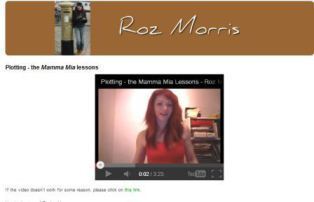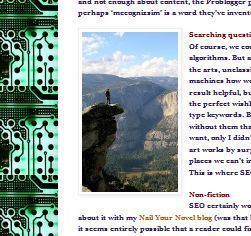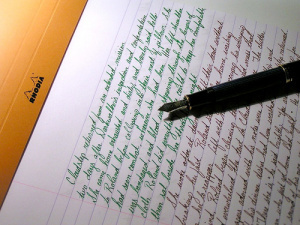Roz Morris's Blog, page 86
March 8, 2013
The ABBA of plotting: video at Beyondaries
 I’m at Chila Woychik’s Beyondaries ezine today, musing about what it might have been like to take ABBA’s back catalogue and try to write the plot of Mamma Mia. Those of you who’ve followed this blog since its first days might recognise the post. It was one of my very earliest, but evapourated when I moved from self-hosting. So here it is again with hand-waving. (If you remember it from – gulp – 2009, wave back in the comments.)
I’m at Chila Woychik’s Beyondaries ezine today, musing about what it might have been like to take ABBA’s back catalogue and try to write the plot of Mamma Mia. Those of you who’ve followed this blog since its first days might recognise the post. It was one of my very earliest, but evapourated when I moved from self-hosting. So here it is again with hand-waving. (If you remember it from – gulp – 2009, wave back in the comments.)
As before, I’m in stimulating company at Beyondaries. Dan Holloway writes about fusing perfume and poetry. Shannon Elizabeth Hardwick talks about tackling the blank page. Grace Bridges talks about stories as ‘the thin places where realities merge’. Small press editor Gray Rinehart describes life as gatekeeper of a slush pile. And proprietrix Chila talks about creativity in the very atoms of the air.
 In the meantime, I’m taking a blogging break this weekend while I plough on with the next book. Nail Your Novel: Bring Characters To Life is due for release in May, so if you’re interested to know more, sign up for my newsletter.
In the meantime, I’m taking a blogging break this weekend while I plough on with the next book. Nail Your Novel: Bring Characters To Life is due for release in May, so if you’re interested to know more, sign up for my newsletter.


March 7, 2013
Not sure how to market your book? Maybe you already know… guest post at Michael Schein Communications
 To my surprise, I find myself guesting today on the blog of marketing and communications consultant Michael Schein. I thought I knew zilch about marketing; certainly not enough to share with those who possess business genes. But Michael contacted me after reading Nail Your Novel and asked if he could pitch me some questions.
To my surprise, I find myself guesting today on the blog of marketing and communications consultant Michael Schein. I thought I knew zilch about marketing; certainly not enough to share with those who possess business genes. But Michael contacted me after reading Nail Your Novel and asked if he could pitch me some questions.
Once I got my teeth into them, I realised that storytellers and advertisers run on adjacent rails. The sensitivities we use as novelists could serve us well when we have to intrigue the world about our books or write blurbs and pitches. Although we still have to identify where our readers hang out, writers of fiction are well equipped to sell ourselves and our work. Come and see.


March 5, 2013
‘Friendship, betrayal and making sense of the past’ – The Undercover Soundtrack, Catherine Czerkawska
Yo u may recognise the name of my guest this week. She was one of my earliest Soundtrackers and she returns this week with a novel of friendship and betrayal: a man looking back on his youth and making sense of a troubled history. It’s set in Glasgow, and traditional Scottish music gave her both geographical setting and emotional landscape: the depth in apparent simplicity, the universal condition of loving and losing. She is novelist and award-winning playwright Catherine Czerkawska; the novel is The Physic Garden and she’s on the Red Blog with its Undercover Soundtrack.
u may recognise the name of my guest this week. She was one of my earliest Soundtrackers and she returns this week with a novel of friendship and betrayal: a man looking back on his youth and making sense of a troubled history. It’s set in Glasgow, and traditional Scottish music gave her both geographical setting and emotional landscape: the depth in apparent simplicity, the universal condition of loving and losing. She is novelist and award-winning playwright Catherine Czerkawska; the novel is The Physic Garden and she’s on the Red Blog with its Undercover Soundtrack.


March 3, 2013
How to cut a novel (and enjoy it)
 I did my first bookshop signing yesterday. Big landmark! It was a terrific day, lots of people (which was a relief). The local writing group came in force and one question came up time and again. ‘My manuscripts end up so long. What should I do?’
I did my first bookshop signing yesterday. Big landmark! It was a terrific day, lots of people (which was a relief). The local writing group came in force and one question came up time and again. ‘My manuscripts end up so long. What should I do?’
Many of their novels were tipping 150,000 words. One gentleman was turning out whoppers of 500,000 and knew he needed to do something about it. But what?
How long is too long?
Actually, length is not a question of wordcount. It’s about pacing. No book seems too long if the material has been handled well. A tome of 100,000 words will read like lightning if it is well paced. A novel of half the length will be a tedious trudge if the pacing is poor.
Of course, the book may be considered too long because of the market and genre. That’s a whole subject in itself. But let’s assume for today that you can have any length you like, so long as it is, like Goldilocks’s porridge, just right.
Pace
What is good pacing? It’s holding the attention of the reader. Plot revelations come at just the right speed. Not just plot, but emotional highs and lows, notes of comic relief, moments of growing tension. Well-paced novels keep the reader up past their bedtime.
Coherence
A novel also reads smoothly if it is coherent. Whether it’s a simple story of two friends or a sweeping epic with seven protagonists and a plot that spans a century, it holds together as one elegant work. Like a well-designed room, everything has a place and it belongs. The material is under control. The more a reader feels the author has this authority, the more they will be gripped.
So when a reader, critique partner or editor tells you the novel is too long, they usually mean you need to fine-tune its coherence and pace. You need to make it a more compelling read.
Why do novels end up too long?
Three reasons:
the writer was having fun and went off at a tangent – nothing wrong with that, it’s part of the organic growth of the novel
the writer found it was more difficult than they expected to get their characters from A to B – again, this is good and will make your novel unpredictable, organic and true
- and most important – it’s almost impossible to keep control of coherence and pace while you are writing. You have to tackle these issues once you have the manuscript complete, and can see what belongs and what needs emphasis. (Some of the writers I spoke to yesterday were surprised by the concept of revising. Especially that revising was an essential, radically artistic process, rather than a quick brush-down for spelling tweaks.)
Take a break, then make a beat sheet
Readers of my book Nail Your Novel: Why Writers Abandon Books and How You Can Draft, Fix and Finish With Confidence will be familiar with these two steps. To edit productively, you need critical distance. So take a break. Write something else. Lock your manuscript away until you’ve forgotten most of it. Most of us need at least a month, but the longer the better.
Then make a beat sheet. This is my ultimate revision tool. Before I start editing, I need a way to grasp the structure of the entire book. So I make a summary of each scene’s purpose – why it’s in the story, whether it advances the plot or our knowledge of a character. I use this to decide if I have scenes that aren’t necessary, or are in the wrong place or if they repeat other material.
When I start editing, I’m feeling my way. With each pass, I climb further inside the novel. I understand what every scene and character should do, and realise whether to emphasise or condense.
It’s as if cutting is like marathon training. To start with, I make light, obvious excisions. Repeated words, over-long descriptive passages, portions of scenes that go nowhere. By the end, which may be weeks or even months later, I’m hardcore. I’ll think nothing of reordering a whole sequence of scenes, downgrading a character’s role or merging them with another person. I will gladly let go of ‘darlings’ – scenes, descriptions, characters and plot developments that are there only because I like them, and not because they are needed. (I may have to add scenes too.)
Cutting is creative
Cutting a book can sound like a negative, dispiriting process – another reason why some writers find it difficult. In fact is creative, not destructive. Although the net effect is a tighter wordcount, we’re not throwing material away but discovering what’s not needed. It’s a process of refinement. I love it because it’s where the book develops its distinct personality and identity.
 The beat sheet is in Nail Your Novel: Why Writers Abandon Books and How You Can Draft, Fix and Finish With Confidence
The beat sheet is in Nail Your Novel: Why Writers Abandon Books and How You Can Draft, Fix and Finish With Confidence
And… announcement! You may have noticed a new cover has appeared in the sidebar. Nail Your Novel: Bring Characters To Life is due for release in May, so if you’re interested to know more, sign up for my newsletter.
Thanks for the swordsmen pics CarrieLu
Do you like cutting your novels? Do you have any tips to add?


February 27, 2013
‘Music and creativity is for everyone – and life can be a musical’ – The Undercover Soundtrack, Cally Phillips
 My guest this week has always made up lyrics, whether alternate versions of existing songs or not-terribly-serious inventions of her own. She says she wishes life was more like a musical, where people might burst out singing if the fancy takes them. Her deep-held belief that life should be lived with lusty vocals led to a collaboration with a theatre group for adults with learning disabilities, and, by circular means, a novel that commemorates the experience – A Week With No Labels. She is screenwriter, playwright and novelist Cally Phillips and she’s on the Red Blog with her very individual Undercover Soundtrack.
My guest this week has always made up lyrics, whether alternate versions of existing songs or not-terribly-serious inventions of her own. She says she wishes life was more like a musical, where people might burst out singing if the fancy takes them. Her deep-held belief that life should be lived with lusty vocals led to a collaboration with a theatre group for adults with learning disabilities, and, by circular means, a novel that commemorates the experience – A Week With No Labels. She is screenwriter, playwright and novelist Cally Phillips and she’s on the Red Blog with her very individual Undercover Soundtrack.


February 24, 2013
How to get a great cover design – when you don’t know what it should be
 Your novel’s cover is make or break, especially if you’re an indie. Whether you do your own art or use a designer, you have to know your book’s market and what will grab the right readers.
Your novel’s cover is make or break, especially if you’re an indie. Whether you do your own art or use a designer, you have to know your book’s market and what will grab the right readers.
I tweeted two posts this week where indie authors wrote about working with cover designers – one by Andrew Kaufman at Crime Fiction Collective and the other by Terry Odell at Blood-Red Pencil.
They talk about an exciting two-way process where they discuss images and typographical treatments. But you can’t direct a designer unless you know what your cover should say. And that’s my problem with Life Form Three, which I’ve decided I’ll publish later this year. Perhaps it’s yours too, especially if you have a novel you’re told is too original and doesn’t fit a genre. This is how I’ve solved it.
I decided to do market research. And it’s turned out to be incredibly helpful.
What I did
I picked an emblematic scene from the book and roughed out a cover to illustrate it. I sent it to friends, who I figured might like the book but in different ways. I included a few hyper-critical writers too, because I knew they would give me the truth.
I also found I got more honest critical comment when I asked friends to show the cover to their spouses and report back. If the spouse didn’t have to worry about hurting my feelings, they were far more brutal.
I didn’t ask: ‘do you like this cover’. A ‘yes’ or ‘no’ doesn’t tell you anything. Instead my questions were: What is this book about? What does it say to you? (They’ll tell you anyway whether they like it.)
Do they already know anything about Life Form Three? No – and that’s the point. They are interpreters telling me what I’ve just said in a language I don’t yet speak. I thanked them for their feedback and explained that I wasn’t going to tell them whether their responses were on the right track or not in case I needed to use them again.
And repeat
I repeated the experiment with another rough cover in a very different style, and gathered another bunch of useful responses. I added more guinea pigs who hadn’t seen the previous version.
What did it cost?
Nothing, except time researching images (which was considerable – so start well in advance). The pictures for the first cover were roughs from photo libraries, which they’ll let you download free to make dummy designs. The second cover was a detail from a painting I knew I could license. I can’t show you either of them here because I don’t have the reproduction rights. (Also, I don’t want you to get the wrong idea – my jurors have been sworn to secrecy!)
Did it work?
Totally. I was very surprised by some of the responses – and that showed how much I needed their feedback. And this brings me to another point. Don’t do a test if the results won’t influence what you do next. With both trial covers, I thought I was onto a good concept. When I tested them, I discovered flaws I couldn’t have thought of.
But after these two exercises, I have clarity. Even though neither cover was right, I know what the real thing should say and I can brief a designer. (And my guinea pigs are still in suspense…)
The brief
What kind of brief do you need to provide? A designer won’t have time to read your book. Send a synopsis that captures not just the events but gives a flavour of the storytelling style. Also list the target audience including age group, imagery and themes that might be of special significance or scenes that could carry the spirit of the whole work. Also explain why you chose the title, as the art should enhance it or create intriguing tension. And let the designer know if you want to leave room for blurb quotes and loglines.
Do it early
I’m not going to publish Life Form Three until at least autumn, but I need the cover in advance because that will set the tone for everything else. The blurb and any publicity materials will be created to make sense of it. So it’s essential that the book’s outside is faithful to the inside.
Footnote: how the other half lives
Funnily enough, as I’ve been moving mountains for the right cover, a traditionally published friend is having a very different experience. I know indies are probably past the stage where we have to stress that our production processes are up to professional standards, but this left me reeling.
Out of the blue my author friend was sent a cover by the art director. He hadn’t been consulted about it. It would be worth getting his input too, as he’s been a bestselling children’s author for more than a decade and knows what covers have sold well to his readership. He tells me that when he signed the contract he emailed the art director and offered to send briefing notes, but was curtly told: ‘We don’t need your notes. We know what we’re doing’.
So did they? No. The cover they designed was catastrophically inappropriate. They didn’t ask about the the age group, so they made it look too juvenile. While the book’s competitors have slick images that look like computer games, this cover featured big typography (ie it was cheaper than proper art) and thumbnail graphics. Even the font gave the wrong messages – it suggested the setting was the wild west, whereas the book is set in ancient Persia. Now the author is locked in a dispiriting argument with the publisher about a cover he knows will be a disaster.
You know what? I’m glad I have control of my cover.
How have you decided what to put on the cover of your novel? How have you made sure it sends the right signals? Have you changed a cover so that it could find its true audience?
(I haven’t finished with covers yet. I may need jurors for Life Form Three Version 3. If you’d like to be one of the secret clan, email me or sign up to my newsletter)


February 20, 2013
How do we discover what to read? Post at Authors Electric
 Sorry, you got two trailer posts from me today. It’s my turn at Authors Electric, where I’m wondering how relevant SEO is for fiction writers and readers.
Sorry, you got two trailer posts from me today. It’s my turn at Authors Electric, where I’m wondering how relevant SEO is for fiction writers and readers.
It all started when I saw a link to a post on Problogger which advised bloggers to stop running guest posts with a lot of links because of new Google algorithms. Undercover Soundtrack host, please note. This led to a fun, fulminating conversation with Facebook friends Cyd Madsen, Vivienne Tuffnell and Beth Rudetsky about tails wagging dogs. But getting our work discovered is a real issue for writers, and at Authors Electric I’m wondering how that’s done. Come over and join the debate.
(Thanks for the pic Daveynin)


‘Very French; and weighed down by heat and melancholy’ – The Undercover Soundtrack, Claire King
 I’ve now got Eric Satie’s Gnossiennes on repeat in my head – and so will you once you’ve read this week’s Undercover Soundtrack. Satie helped my guest conjure a lulling, heady summer in France; a five-year-old girl running wild while her mother grapples with tragedy, late pregnancy and looming disaster. The novel is The Night Rainbow, the author is Claire King, and she’s on the Red Blog with her Undercover Soundtrack. Even better, you could win a copy for sharing the post and commenting!
I’ve now got Eric Satie’s Gnossiennes on repeat in my head – and so will you once you’ve read this week’s Undercover Soundtrack. Satie helped my guest conjure a lulling, heady summer in France; a five-year-old girl running wild while her mother grapples with tragedy, late pregnancy and looming disaster. The novel is The Night Rainbow, the author is Claire King, and she’s on the Red Blog with her Undercover Soundtrack. Even better, you could win a copy for sharing the post and commenting!


February 17, 2013
Do you need a literary agent?
 I had this note from a new blog subscriber.
I had this note from a new blog subscriber.
I’ve just finished my first novel. A most enjoyable experience only tainted by the reaction from the literary agents I have approached so far! Any and all advice and direction will be gratefully received and much appreciated.
Although we’re now used to writers who publish themselves, there is still a sizeable crowd who are set on finding an agent and a traditional publishing deal. Most of my critique clients, for instance. Why?
1 – Kudos and confidence
If you have an agent or a publisher, you have validation. You’re not just a spare-time scribbler, which you have probably been for countless years before. If you get an agent, your friends, family, total strangers – and you yourself – have proof that you made the grade.
This cannot be underestimated. Getting an agent took me years. By the time I did, I’d already got ghosted bestsellers and a track record coaching writers. But I felt I was sneaking under the wire, using the title ‘writer’ on false pretences until an agent signed me for My Memories of a Future Life.
2 – Developmental input
We all need developmental help. If you’re a good fit for an agent, they can give you perceptive, priceless notes on how your book works and guide your revisions.
3 – Long-term career-building
Obviously, an agent helps you find a publisher, usually with a better deal than you could get on your own.
But agents can’t always sell your first book, and often the only choice is to self-publish. Some agents are giving writers a leg-up with showcase imprints of their own – Jason Allen Ashlock at Movable Type Management set up The Rogue Reader to launch outsider suspense writers. As publishers increasingly opt for ‘safe’ books, we’ll see more agents devising ways to build audiences for their exciting new authors.
So I still think it’s worth looking for an agent. Markets change and new opportunities are opening for writers all the time. If you can, it makes sense to get the support of professionals with more legal and commercial clout than you can muster on your own.
But every silver lining has a cloud. Here are two.
 1 Editorial input: the flipside
1 Editorial input: the flipside
If an agent gives you editorial input, they might be steering you to fit a commercially viable genre. That might completely suit you. But it may not if your aim is to pursue a more individual and creative path. You still don’t have to abandon dreams of traditional publication; many small presses will take submissions directly from authors.
2 Self-publishing
Almost every writer will probably now self-publish at some stage, but not all agents have adjusted to this. I know successful indie authors who have been offered agency deals that claim a percentage of all book earnings – which of course includes royalties from books they published themselves. This was appropriate when all the author’s work came through the agent, but now is plainly unfair. Happily, many agency agreements demand commission only on deals that they have made. If you’re offered a deal that takes a percentage of everything, query it. They might adjust the wording. If not, think hard about whether you want to work with them.
3 The disreputable
Not all agents are reputable. Some ask for money up front to read your manuscript. Even with all the boundaries shifting, an agent should never charge to read your work. Agents earn commission on the back end.
So what do we make of our correspondent here, whose quest for an agent is proving a challenge? Why might you have trouble finding an agent?
1 – Your book may not yet be strong enough. It’s so easy to send off our lovely novel too early. If you nearly made the cut, most agents will try to let you know. But if they dismiss you with the equivalent of a compliments slip, you may need to hone your craft.
2 – You might have pitched the wrong agents – either their lists are full, or they don’t take your genre. Check websites before you hit ‘send’ (although agents are often quite bad at updating their requirements).
3 – You might have a great book but a dull pitch. Pitching is an art and you need to know how to make an agent curious.
4 – Your book may not be commercially viable. You might get feedback about genre mixing, undesirable subjects or unfashionable style choices. Your book might still be a good read in spite of this – and if so, agents are usually genuine enough to let you know.
5 – You might need to kiss more frogs. There are thousands of agents, all very oversubscribed, all with different wishlists. With such pressures, rejection is far more likely than acceptance, even for awesome books. Don’t do anything different until you see a reliable pattern emerge.
Thanks for the cafe table pic Tony Hall and the inkpen manuscript pic Songwind
Anyway, I’m hoping this will kick off a discussion. What’s your feeling about agents? What would you advise our friend here?


February 13, 2013
‘Neon, nostalgia, regret and joy’ – The Undercover Soundtrack, Dan Holloway
 Another familiar face this week – one of the first Soundtrack contributors returns with a new poetry collection. i cannot bring myself to look at walls in case you graffiti them with love poetry, which you’ll notice is be-eecummingly lower case. It’s a lyrical, heartbreaking, but ultimately joyous celebration of lost friends – with prog-rock tendencies. In a subversive nod to pink-hearts week, Dan Holloway is on the Red Blog with his latest Undercover Soundtrack.
Another familiar face this week – one of the first Soundtrack contributors returns with a new poetry collection. i cannot bring myself to look at walls in case you graffiti them with love poetry, which you’ll notice is be-eecummingly lower case. It’s a lyrical, heartbreaking, but ultimately joyous celebration of lost friends – with prog-rock tendencies. In a subversive nod to pink-hearts week, Dan Holloway is on the Red Blog with his latest Undercover Soundtrack.








